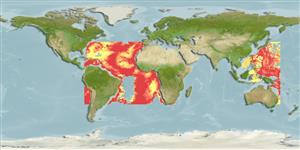Teleostei (teleosts) >
Aulopiformes (Grinners) >
Ipnopidae (Deep-sea tripod fishes) > Ipnopinae
Etymology: Bathypterois: Greek, bathys = deep + Greek, pterois = with wings (Ref. 45335).
More on author: Günther.
Environment: milieu / climate zone / depth range / distribution range
Ecology
Marine; bathydemersal; depth range 2615 - 5610 m (Ref. 3590). Deep-water; 0°C - 5°C (Ref. 3590); 40°N - 35°S, 79°W - 156°E
Atlantic Ocean: Off northwestern (south of Cape Verde; off Cape Blanc) and southwestern Africa, both sides of North Atlantic, off Uruguay in the South Atlantic. Elsewhere, widely scattered localities in the Pacific.
Size / Weight / Age
Maturity: Lm ? range ? - ? cm
Max length : 24.9 cm SL male/unsexed; (Ref. 3590)
Solitary. Occurs in waters with a temperature range of 4.5-0.4°C (Ref. 3590). Uses its specialized fin rays (tripod) to elevate body into water column. Specialized sensory pectoral fins are spread facing anteriorly, probably to detect prey. Feeds on planktonic crustaceans. Synchronously hermaphroditic (Ref. 6688).
Life cycle and mating behavior
Maturity | Reproduction | Spawning | Eggs | Fecundity | Larvae
Merrett, N.R., 1990. Chlorophthalmidae. p. 351-360. In J.C. Quero, J.C. Hureau, C. Karrer, A. Post and L. Saldanha (eds.) Check-list of the fishes of the eastern tropical Atlantic (CLOFETA). JNICT, Lisbon; SEI, Paris; and UNESCO, Paris. Vol. 1. (Ref. 3590)
IUCN Red List Status (Ref. 130435)
Threat to humans
Harmless
Human uses
More information
Common namesSynonymsMetabolismPredatorsEcotoxicologyReproductionMaturitySpawningSpawning aggregationFecundityEggsEgg development
Age/Size
Growth
Length-weight
Length-length
Length-frequencies
Morphometrics
Morphology
Larvae
Larval dynamics
Recruitment
Abundance
BRUVS
Tools
Special reports
Download XML
Internet sources
Estimates based on models
Preferred temperature (Ref.
123201): 2.2 - 4.1, mean 2.5 °C (based on 1753 cells).
Phylogenetic diversity index (Ref.
82804): PD
50 = 0.5000 [Uniqueness, from 0.5 = low to 2.0 = high].
Bayesian length-weight: a=0.01000 (0.00244 - 0.04107), b=3.04 (2.81 - 3.27), in cm total length, based on all LWR estimates for this body shape (Ref.
93245).
Trophic level (Ref.
69278): 3.1 ±0.30 se; based on food items.
Resilience (Ref.
120179): Very Low, minimum population doubling time more than 14 years (Preliminary K or Fecundity.).
Fishing Vulnerability (Ref.
59153): Low vulnerability (20 of 100).
